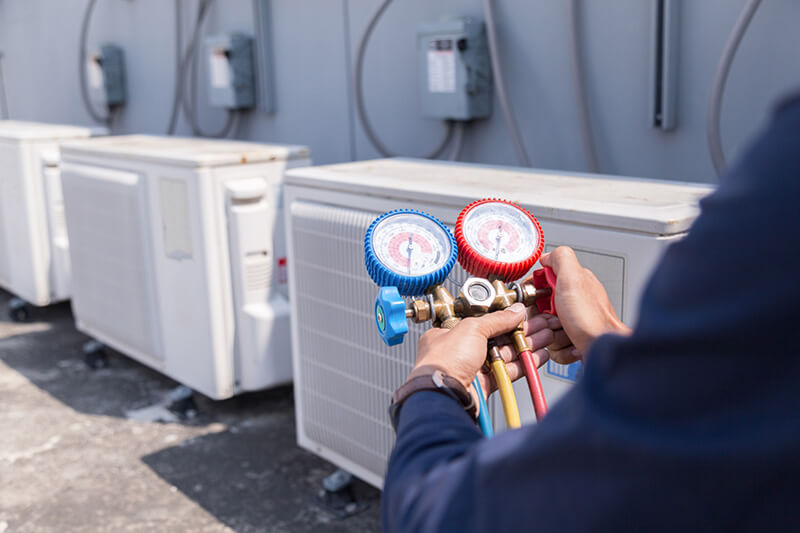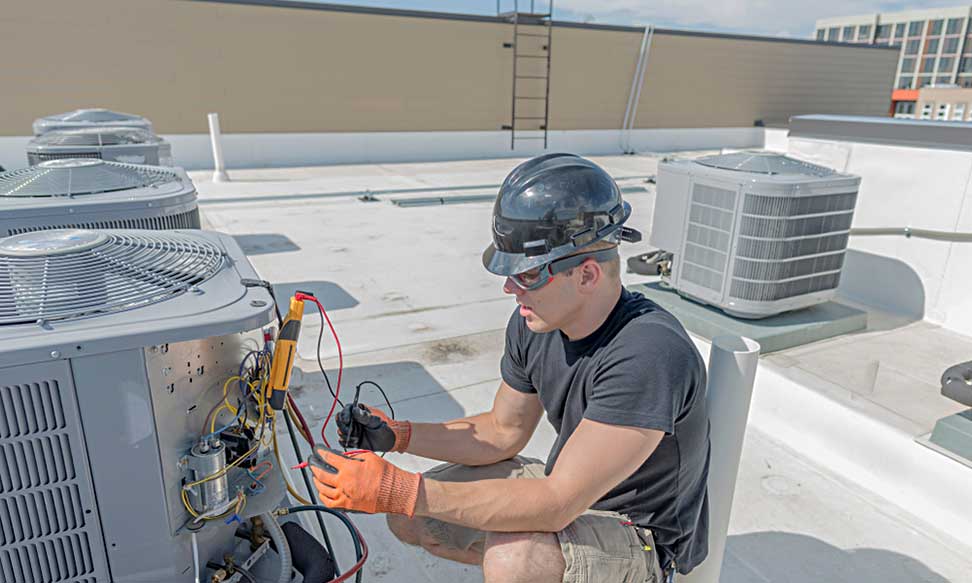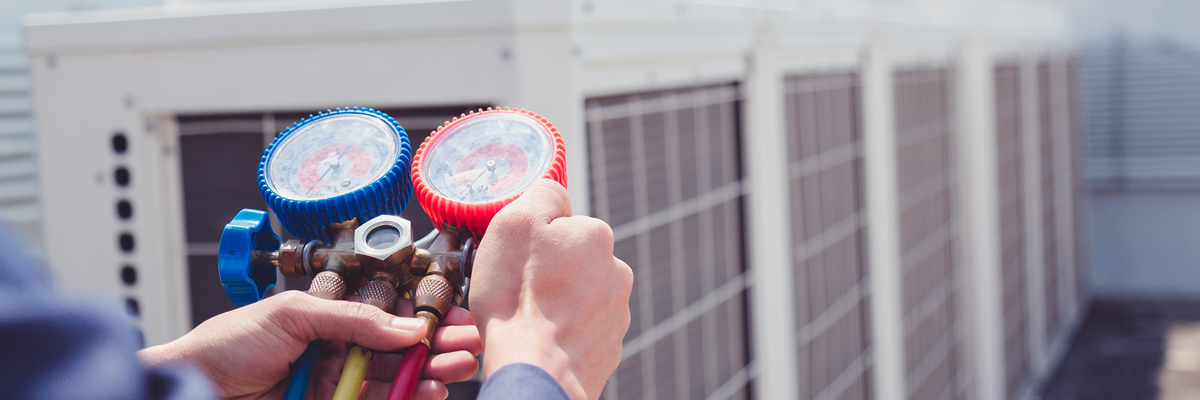A Step-by-Step Walkthrough to heat pump replacement ooltewah tn
A Step-by-Step Walkthrough to heat pump replacement ooltewah tn
Blog Article
How a Warmth Pump and Furnace Collaborate to Maximize Your Home's Heating Efficiency
Understanding exactly how a warm pump and heater job together is vital for property owners seeking efficient home heating services. Each system has its toughness, giving a balanced strategy to home convenience. The heatpump masters modest temperatures, while the heating system provides quick warmth during extreme cold. This harmony not only minimizes energy costs yet also boosts the lifespan of both home appliances. What variables affect this partnership, and exactly how can house owners maximize their advantages?
Understanding Warmth Pumps: How They Function
Numerous individuals might be unfamiliar with their internal operations, heat pumps play a necessary role in modern-day home heating systems. These devices operate by moving warmth from one area to another, making use of the principles of thermodynamics. In cooler months, a warmth pump extracts warm from the outdoors air, ground, or water, and transfers it indoors to warm the space. Conversely, throughout warmer months, it can reverse the process, acting as an air conditioning unit by eliminating warmth from inside to the outside.Heat pumps contain an evaporator, expansion, condenser, and compressor valve. The refrigerant within the system soaks up warmth as it vaporizes at reduced temperatures and pressures. The compressor then boosts the stress and temperature level of the refrigerant, enabling it to release heat as it condenses. This effective procedure can substantially reduce energy usage compared to conventional heating techniques, making heatpump a lasting option for climate control in homes.
The Duty of Furnaces in Home Home Heating
Furnaces play a necessary role in home heating by giving a dependable source of heat during the chillier months. They operate by creating warmth via burning or electrical resistance, distributing it throughout the home via ducts or radiant systems. The performance of a heater is usually gauged by its Yearly Fuel Usage Performance (AFUE) rating, which indicates how efficiently the device converts gas right into heat.Furnaces can make use of various power resources, consisting of natural gas, lp, electrical energy, or oil, allowing home owners to pick one of the most suitable alternative for their requirements. Unlike heatpump, which may struggle in severe chilly, heating systems preserve regular efficiency, making sure that interior temperatures continue to be comfortable despite outside problems. Additionally, modern-day furnaces commonly come equipped with innovative innovation, such as clever thermostats and variable-speed blowers, improving their efficiency and responsiveness. This adaptability makes furnaces a vital element in all-encompassing home heating strategies.

Advantages of Utilizing Both Solutions Together
Integrating the staminas of both furnaces and warmth pumps can bring about a more effective and reliable home heating service. Using both systems allows home owners to make the most of the heatpump's energy performance throughout milder temperatures while counting on the heater for more extreme cold problems. This double strategy can significantly minimize power costs, as warm pumps consume much less electrical power than standard home heating approaches when temperature levels are moderate.Additionally, using both systems together can boost convenience levels in the home. Warmth pumps can provide regular, also home heating, while heaters can swiftly raise ambient temperatures when required. The integration of both systems can expand the lifespan of devices by reducing wear and tear on each device, as they share the workload. Ultimately, homeowners can take pleasure in a well balanced, affordable heating solution that adjusts effortlessly to varying weather, making certain a warm and welcoming home throughout the cold weather.
How Warm Pumps and Furnaces Complement Each Other
They develop a corresponding home heating system that maximizes efficiency and comfort when property owners integrate warm pumps and heating systems. Warm pumps operate by transferring warmth from the outdoors air or ground, making them very reliable in modest environments. They stand out throughout milder temperature levels, giving cost-effective heating. On the other hand, heating systems produce warm with combustion or electric resistance, delivering strong, prompt heat throughout severe cool conditions.The combination of these 2 systems enables dynamic modifications based on temperature level variations. During warmer months or milder winter days, the heatpump can take the lead, preserving power and minimizing prices. As temperature levels decrease, the heating system can perfectly involve, ensuring regular heat throughout the home. This synergy not just optimizes power usage however also enhances the lifespan of both systems, as each unit runs within its ideal performance array. Together, they create a well balanced atmosphere that adapts to differing climate needs.
Enhancing Performance: Tips for Homeowners
Homeowners can boost their home heating effectiveness through numerous useful approaches. Establishing a routine maintenance routine, incorporating wise thermostat technology, and implementing efficient insulation and securing services are vital steps. These actions not only boost comfort yet likewise decrease energy prices.
Routine Upkeep Schedule
To assure maximum heating efficiency, establishing a normal upkeep routine is crucial for any kind of home. Property owners need to prioritize routine assessments of both heat pumps and heaters to determine peak efficiency. This includes altering air filters each to three months, as clogged filters can significantly decrease efficiency. In addition, scheduling specialist maintenance a minimum of yearly allows professionals to identify and deal with possible issues before they intensify. Homeowners need to also clean up the heatpump's outside device to stop debris accumulation that can impede air flow. By adhering to a normal upkeep timetable, homeowners not only improve their furnace' performance yet additionally extend their life expectancy, bring about better convenience and minimized energy costs throughout the colder months.
Smart Thermostat Assimilation
Integrating a wise thermostat into a home heating unit can significantly boost energy performance, particularly as it enables for precise control over temperature settings. These tools can discover the property owner's timetable and choices, immediately adjusting the temperature level to enhance convenience while reducing energy usage. For example, they can lower home heating during times when the home is empty, minimizing unneeded intake. Several clever thermostats likewise provide real-time energy use data, making it possible for property owners to make educated choices regarding their heating practices. In addition, remote accessibility through smart device apps permits individuals to change setups from anywhere, making sure the home is warm upon return. Generally, wise thermostat assimilation not only enhances convenience but substantially adds to power financial savings and effectiveness.
Insulation and Securing Solutions
Smart thermostats play an important duty in energy efficiency, yet their effectiveness can be substantially improved by appropriate insulation and securing solutions. House owners should focus on insulating floorings, attic rooms, and wall surfaces to decrease heat loss. High-grade insulation materials, such as spray foam or fiberglass, published here can significantly boost thermal resistance. Additionally, securing voids around doors, air ducts, and home windows prevents cool air infiltration and heat escape. Weatherstripping and caulking work approaches for dealing with these leakages - heat pump installation ooltewah tn. Regular assessments for air leaks, in addition to using blower door tests, can help determine problem locations. By investing in insulation and securing, property owners can optimize the efficiency of their heating unit, eventually bring about minimized power consumption and reduced utility expenses
Usual Misconceptions Regarding Warmth Pumps and Furnaces
What misconceptions border heat pumps and heaters? Many people incorrectly think why not try here that heatpump are inadequate in cooler environments. In truth, modern-day heatpump are created to operate successfully even in low temperatures, supplying reliable home heating throughout winter season. Another common misconception is that furnaces are constantly a lot more efficient than heatpump. Nonetheless, this depends on the particular energy resources and performance rankings of the units concerned. Some may likewise assume that making use of both systems at the same time is unnecessary, however actually, this combination can optimize home heating effectiveness, especially during severe weather. In addition, individuals frequently assume that heat pumps call for continuous upkeep, when in reality, they have similar upkeep needs to conventional heating systems. By unmasking these myths, house owners can make even more enlightened decisions regarding their home heating choices, eventually bring about enhanced comfort and power effectiveness in their homes.
Upkeep Considerations for Combined Systems

Regularly Asked Inquiries
Can Warmth Pumps Work Successfully in Exceptionally Cold Climates?
Heatpump can struggle in incredibly cold environments as a result of minimized efficiency and heat removal constraints. Nonetheless, advancements in innovation have brought about versions developed for much better performance in such problems, improving their stability in rough environments.
How Much Time Do Warmth Pumps and Furnaces Usually Last?
Warmth pumps usually last 15 to twenty years, while furnaces have a life-span of 15 to thirty years. Regular upkeep can extend their longevity, making sure efficient procedure and decreasing the need for early replacements.

What Is the Average Price of Setting Up Both Systems?
The ordinary cost of installing both a heat pump and a heating system commonly varies between $5,000 to $10,000 - furnace replacement. Variables affecting this price include system size, setup complexity, and local labor prices
Are There Tax Obligation Motivations for Utilizing Energy-Efficient Heating Systems?
Many home owners ask about tax rewards for energy-efficient heater. Different government and state programs frequently supply credit ratings or rebates, encouraging the adoption of sustainable technologies to minimize power consumption and promote environmental responsibility.
How Do I Choose the Right Dimension Heatpump and Heating System?
Selecting the ideal dimension heatpump and heater entails calculating the home's square video, considering insulation top quality, and examining local climate. Consulting a professional can guarantee optimal system performance and energy efficiency based on details demands. heat pump service. Recognizing exactly how a warm pump and heater work with each other is necessary for house owners looking for effective heating services. In cooler months, a warmth pump removes heat from the outside air, ground, or water, and transfers it indoors to warm up the living area. When home owners integrate warmth pumps and furnaces, they produce a corresponding heating system that takes full advantage of efficiency and convenience. Heat pumps run by transferring warmth from the outside air or ground, making them highly effective in moderate environments. Heat pumps can struggle in very chilly environments due to lowered efficiency and warmth removal limitations
Report this page